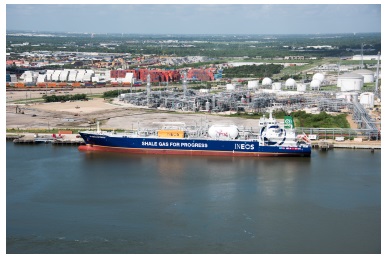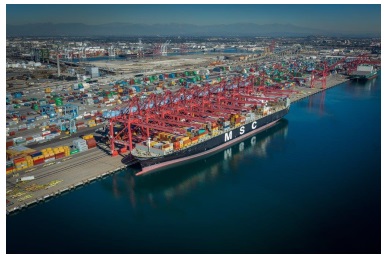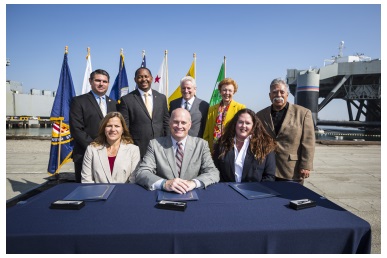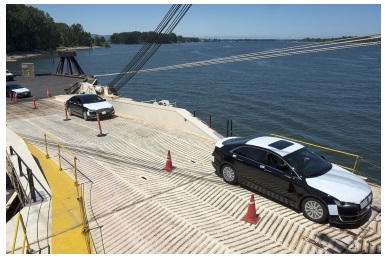Facility Expansion: Houston, Long Beach, Portland (OR)
![]() Print this Article | Send to Colleague
Print this Article | Send to Colleague
Ethane Facility Starts Service at Port of Houston

New Enterprise Products thane export terminal in the Port of Houston
Photo/Enterprise
Enterprise Products Partners L.P. (Enterprise) announced September 1 that service has begun at its newest ethane export terminal. M/V JS INEOS Intrepid set sail that morning with the first cargo of ethane export from the Enterprise facility at Morgan’s Point in the Port of Houston.
Enterprise signed a long-term agreement with the Port of Houston Authority for use of its facilities adjacent to Enterprise’s existing terminal at Morgan’s Point. The Enterprise project is among a host of projects and expansions being carried out along the channel fostering positive economic impact for the region and state of Texas.
"The energy renaissance in the state of Texas is further illustrated with the arrival of the first Ethane ship to Enterprise Products at its new facility at the Port of Houston," said Port Commission Chairman Janiece Longoria." "As the port authority continues to generate jobs and economic impact for the entire region, we are excited to share this historical event with Enterprise. Our long term lease with Enterprise underscores our mission and vision to ‘grow and diversify the business base’ and ‘sustain the business for the long-term.’"
Houston is home to the largest petrochemical manufacturing complex in the United States and the nation’s top handler of petroleum cargo based on tonnage throughput.
Long Beach Port Commemorates Navy Property Transfer Commemorated, Accepts Additional 125 Acres for Cargo Operations

Long Beach’s busy Terminal T container complex sits on acreage formerly occupied by the Long Beach Naval Station and Naval Shipyard.
Photo/Port of Long Beach
U.S. Navy, Maritime Administration (MARAD) and California Environmental Protection Agency representatives joined city and port officials on August 30 to commemorate the approval to transfer ownership of 125 acres of the former Naval Complex to the City of Long Beach.
The property transfer commemoration highlighted the economic success of a thriving shipping terminal and other operations at the former Navy facility. Pier T ranks among the busiest container terminals at the Port of Long Beach — able to accommodate megaships and handling billions of dollars’ worth of trade.
The acreage was part of the former Long Beach Naval Station and Naval Shipyard on Terminal Island that the Navy agreed to transfer to the port as part of the ongoing defense base closures that started with the collapse of the Soviet Union and the end of the Cold War in the late 1980s.
U.S. Navy and city officials first worked out a lease agreement for the Harbor Department to take control of the 500-acre complex on Terminal Island in 1998, allowing the port to break ground on the new container terminal. The official transfer of ownership is taking place in stages, as environmental issues are resolved.
In 2001, the Navy deeded more than half the property to the City of Long Beach. After the current transfer of 125 acres, just two smaller parcels remain to be transferred in the next few years. MARAD is facilitating the process for this site under its Port Conveyance Program.
"The Navy Base Realignment and Closure team is proud to have played a key role ensuring these 125 acres were environmentally suitable for transfer and continued port-related reuse," said Kim Ostrowski, the Director of the Navy Base Realignment and Closure Program Management Office West. "Any effort of this magnitude takes a great deal of teamwork; the Navy and the Port of Long Beach, along with state and federal regulatory agencies, have worked diligently to develop and implement cost-effective cleanup solutions to facilitate this property transfer."
The Navy’s presence on Terminal Island began with the purchase of 100 acres from the city in 1940, during the lead-up to World War II.
The land transfer is proceeding in steps to allow for environmental cleanup of the property as needed. Depending on the condition of the land, the process has allowed for most of the property to be safely developed and used as soil and sediment investigations are being completed.
In addition to the Total Terminals International container shipping terminal on Pier T, the former Navy property is also home to Energia Logistics United States, which operates a satellite-launching company known as Sea-Launch. It also provides docking facilities for Ready Reserve Force vessels maintained by MARAD on behalf of the Navy.
"This property transfer is a symbol of the successful partnership between the Navy, MARAD and the City of Long Beach that turned the closure of a major Navy facility into a thriving commercial terminal," said Harbor Commissioner Tracy Egoscue. "The transformation of the Naval Complex into a shipping terminal has been a major step forward. The Commission thanks the many people and agencies involved."

Seated, from left: Kim Ostrowski, Director of the Navy Base Realignment and Closure Program Management Office West; Maritime Administrator Paul "Chip" Jaenichen; Harbor Commissioner Tracy Egoscue. Standing, from left: Richard Cameron, Port Managing Director of Environmental Affairs and Planning; Long Beach Vice Mayor Rex Richardson; Port CEO Jon Slangerup; former Long Beach Mayor Beverly O'Neill; and Long Beach Councilmember Roberto Uranga.
Photo/Port of Long Beach
Portland: Auto Export Business Growth Drives ConnectOregon Grant
The Oregon Department of Transportation has awarded a $2.6 million ConnectOregon grant to the Port of Portland and port tenant Auto Warehousing Co. (AWC) to fund part of a $7 million expansion of auto handling facilities in the Rivergate Industrial District near Terminal 6. Plans call for AWC to develop an 18.9-acre storage and staging yard to support the continued growth of export vehicles.
AWC leased 130 acres at Terminal 6 in 2005 and currently handles the import of Hyundai vehicles into the United States and the export of Ford vehicles manufactured in North America bound for China and South Korea. Export volumes have grown steadily in recent years, bringing the total vehicles moved by AWC to 126,000 in the last 12 months. Across the Port of Portland marine terminals, auto shipments were up 14 percent during the previous fiscal year, which ended in June.
The Port Commission recently approved a lease to AWC for the expansion lot for an initial eight-year term with an additional four, 5-year options. If all options are exercised, the lease would extend to April 2045. The port committed $871,300 to the project with the tenant providing matching funds of $3.5 million.
ConnectOregon is a lottery-bond-based grant initiative to invest in air, rail, marine, transit, and bicycle and pedestrian infrastructure to ensure a strong, diverse and efficient transportation system in Oregon. Public, private, and non-profit entities are able to apply for grants of up to 70 percent of project costs.
"Exports are the real success story, not just for the Port of Portland, but for the whole American automobile industry," says Sebastian Degens, the port’s director of marine marketing. "International export is a boost to the economy here, as well as in the heartland where the manufacturing takes place."

Loading Ford autos for export at AWC’s Terminal 6 facility in the Port of Portland
Photo/Port of Portland

